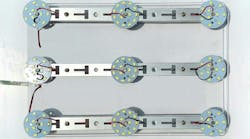Solar Constant Lighting System Uses PV-Pushback-Effect (Download)
Solar day lamps (SDLs) are made by simply connecting an LED array to a solar photovoltaic (PV) panel. SDLs represent a highly cost-effective way of utilizing solar energy for lighting. However, SDLs suffer from drawbacks such as daytime-only lighting, light-intensity fluctuations based on sunlight intensity, and low output on cloudy or rainy days.
To eliminate those drawbacks, a simple mains backup system is proposed. Figure 1 shows the block diagram of solar lighting system using the PV-Pushback-Effect. It consists of a load (here, it’s an SDL) that’s fed from two sources. The first source is the solar PV power and the second source is mains power with an AC-DC converter. Before connecting these two power sources, a diode and resistor are connected in series with their respective output terminals. The diodes DS and DM ensure that the current from the other source is blocked.
